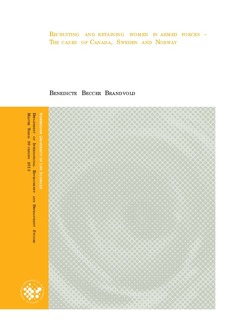Recruiting and retaining women in armed forces : the cases of Canada, Sweden and Norway
Master thesis
Permanent lenke
http://hdl.handle.net/11250/187955Utgivelsesdato
2014-02-17Metadata
Vis full innførselSamlinger
Sammendrag
The objective for the Norwegian Armed Forces was 15 percent women of all soldiers by 2008. Five years later, women only make up between 8 and 9 percent while the new goal is to reach a level of 20 percent women by 2020. This goal currently seems difficult to reach due to the minimal increase of women over the past years. This thesis is a comparative study between Canada, Sweden and Norway, as the two first both have a higher percentage of women serving in their armed forces. The thesis looks at measures taken to recruit and retain women. It also looks at whether the measures have had the desired effect as well as whether any of the measures deals with masculinity cultures that exists within the military organizations. By using a mixture of document analysis and semi-structured interviews, it becomes possible to get insights into the work of these countries’ on reaching the same goal of adopting an international resolution and increase gender equality within the military organization. I use theoretical perspectives to guide the analysis and to explain the empirical findings. Gender research has highlighted how masculinity cultures are persuaded in the military, as well as how women are being discriminated in male dominated occupations. Perspectives on policy implementation explain necessary tools in order to achieve a set objective and by this, why it seems difficult to increase the female participation. The empirical findings show similar measures in many areas within all three countries. These measures seem to vary in terms of width and depth however. Whether the military practice conscription or all-professional forces where men and women apply equally, also seem to contribute to the military’s ability to attract women. Findings further indicate that societal factors like the military organizations’ position in the labor market matters, as well as the time elapsed since action was first taken. To increase the percentage of women and to be able to make these women stay depends on a long- term perspective and deep commitment from politicians and military leaders.
